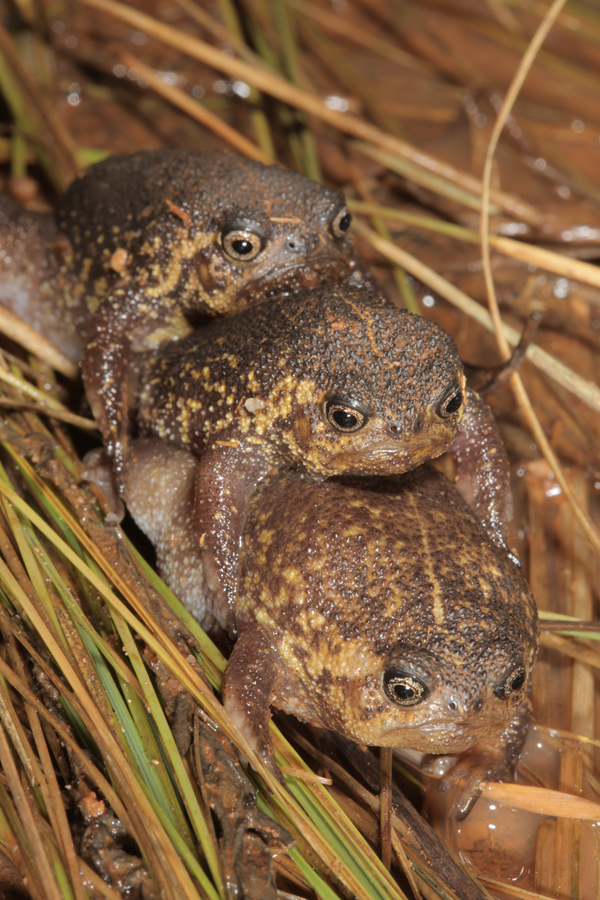In the damp, grassy slopes of the KwaZulu-Natal Midlands, an unassuming amphibian has leapt into the scientific spotlight. Named Breviceps batrachophiliorum – Latin for ‘frog-loving people’ – this newly described species of rain frog is a triumph of taxonomy and a compelling example of the intersection of citizen science and academic rigour.
Professor Louis du Preez of the North-West University (NWU) led the discovery, drawing on his long and distinguished career as a herpetologist. The breakthrough came thanks to three passionate frog enthusiasts: Nick Evans, Dylan Leonard, and Cormack Price. They set out on a mission to spot and document every frog in Prof du Preez’s field guide. One night after some heavy rain, they set out to find the elusive Bilbo’s rain frog (Breviceps bagginsi), named after Bilbo Baggins, from The Lord of the Rings, who also lived in a hole in the ground. When they found what they believed to be a Bilbo’s rain frog, they sent a photograph and an accompanying call recording to Prof du Preez.
“There was something curious,” recalls Prof du Preez. “I thought they had mixed up the images and the sounds. But when I pointed this out, they sent a video, and that’s when I realised that we were looking at a new species.”
What followed was a meticulous analysis process, detailed in the African Journal of Herpetology. The team employed an integrative approach, blending morphology, genetics and, crucially, bioacoustics. The frog’s call, a vital identifier in such a visually cryptic genus, diverged sharply from those of its closest relatives. Genetically, it showed a 7.5% difference in mitochondrial 16S rRNA compared to Breviceps verrucosus. This clear signal indicated that this frog was not only new to science but also worthy of its own species status.
Though short-limbed, round-bodied, and earth-toned, B. batrachophiliorum is far from plain. Its eardrum is unusually visible, a rare feature among its kin, and the position of its mouth sets it apart from B. verrucosus. In acoustic terms, its calls are shorter, faster, and more frequent than those of similar species. Such subtleties are crucial in frog courtship and therefore in species recognition.
Prof du Preez and his co-authors, E.C. Netherlands and L.R. Minter, also stress the importance of this discovery for conservation. With an occupancy area of just 1 108 km², this frog's habitat is largely restricted to three types of mistbelt grassland in the KwaZulu-Natal Midlands. Although some populations occur within protected areas such as the Clairmont Nature Reserve, the species’ limited range raises concerns about its vulnerability to habitat destruction and climate change.
This tale is about more than just taxonomy. It is also a cautionary tale about the fragility of ecological knowledge. The new frog was once misidentified as Bilbo’s rain frog
(Breviceps bagginsi), a mistake with far-reaching consequences. The description of the new species means that Bilbo’s rain frog is now only known to exist in one population in a highly transformed area, and as a result its conservation status jumped to Critically Endangered. With the correction in place, the true distribution range of both species can be assessed more accurately. This is a small but vital victory for conservation science.
Importantly, the discovery highlights a broader trend. Since 2000, over a third of Breviceps species have been described, a surge largely driven by advances in molecular biology and acoustic analysis. South Africa, with its rich and still unfolding biodiversity, is at the heart of this amphibian renaissance.
Ultimately, Breviceps batrachophiliorum is more than just another new name in a long list. It serves as a reminder that discovery still hides in plain sight, and that with enough passion, patience and a bit of rain, even the quietest calls can be heard.

Breviceps batrachophiliorum
